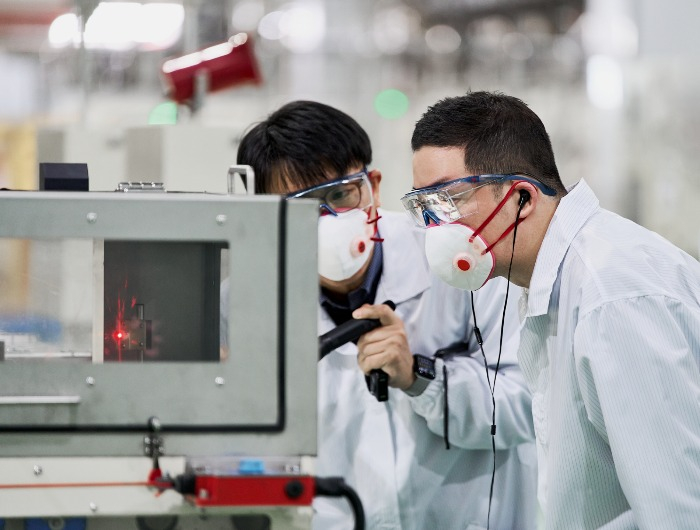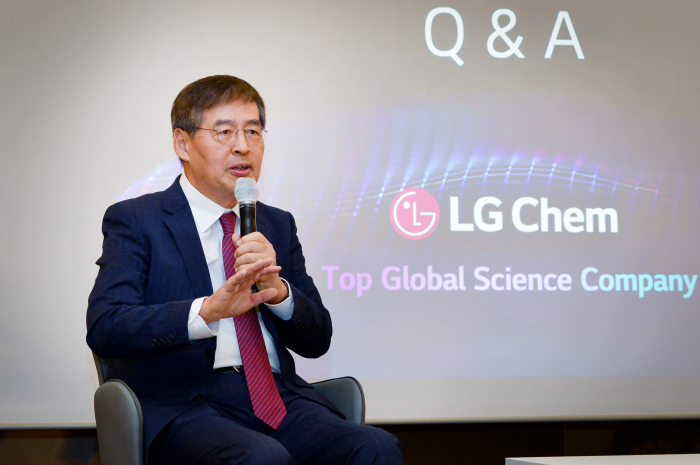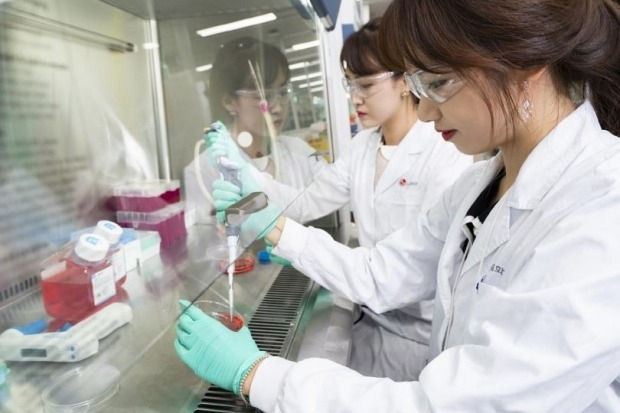LG Chem aims higher for battery materials with diverse portfolio
The petrochemicals-heavy firm is seeking to produce all four major battery materials for the first time in the industry
By May 16, 2023 (Gmt+09:00)
LG Chem to sell water filter business to Glenwood PE for $692 million


KT&G eyes overseas M&A after rejecting activist fund's offer


Kyobo Life poised to buy Japan’s SBI Group-owned savings bank


StockX in merger talks with Naver’s online reseller Kream


Meritz backs half of ex-manager’s $210 mn hedge fund



South Korea’s LG Chem Ltd. on Tuesday revised up its 2030 sales goal for battery materials by 45% after it delivered stronger-than-expected results from rechargeable battery materials last year.
Shin Hak-cheol, vice chairman of the chemical company, said its battery materials sales would jump sixfold to about 30 trillion won ($22 billion) by that year from 4.7 trillion won in 2022.
He made the forecast in a keynote speech at a foreign investors conference hosted by Bank of America in Seoul, noting that the company has been transforming away from being a petrochemicals-centric player.
The sales goal for 2030 is 9 trillion won higher than its previous target of 21 trillion won announced in February 2022. It also represents an average 26% growth in sales per year.
Last year, LG Chem's revenue from battery materials such as cathodes and precursors beat its projection of 2.8 trillion won, coming in at 4.7 trillion won.
Battery materials are one of LG Chem’s three growth pillars, alongside eco-friendly materials and medicines.
The three key businesses are expected to generate a combined 40 trillion won in 2030, accounting for 57% of the company’s total sales projection of 70 trillion won the same year, Shin said.
In 2022, the three businesses made up 21% of LG Chem’s sales.
LG Chem has already made its name in the cathode materials market. Now it is expanding into three other key battery materials, including pure silicon-based anode and electrolyte.
If it starts producing all the four key battery ingredients of cathode, anode, precursor and electrolyte, it will become the world's first company to do so.

CATHODES
For high-nickel cathodes, it will operate manufacturing facilities in its four major markets: Korea, China, the US and Europe.
Those facilities will quadruple LG Chen's combined production capacity of high-nickel cathodes to 470,000 tons per year by 2028 from the current 120,000 tons.
LG Chem has been supplying a big chunk of its high-nickel cathodes to its subsidiary LG Energy Solution Ltd. With the capacity expansion, it hopes to have battery makers other than LG Energy account for 40% of its 2030 sales.
It plans to produce ultra-high-nickel cathodes with a nickel content of 95% within the next few years. A battery cell with a nickel content of more than 80% is classified as a high-nickel battery.
For low-to-medium-priced electric vehicle batteries, LG will develop medium-nickel high-voltage and manganese-rich cathodes, as well as those for lithium iron phosphate (LFP) batteries.
PRECURSORS
It is teaming up with major mineral producers such as China’s Zhejiang Huayou Cobalt Co., Piedmont Lithium Inc., a US mining company, and Kemco, a unit of Korea Zinc Co., to build battery precursor plants.
LG Chem has bought stakes in major lithium suppliers to build partnerships while striving to secure long-term contracts with battery producers.
“LG Chem implemented contingency management systems during the unprecedented pandemic period amid geopolitical conflicts, focusing on new growth engines,” Shin said.

ECO-FRIENDLY MATERIALS, NEW MEDICINES
From eco-friendly materials, LG aims to generate 8 trillion won in revenue by 2030 versus 1.9 trillion won in 2022.
It is zooming in on the plastics recycling market, which is expected to balloon to sales of 100 trillion won by sales by 2028. The company is also eyeing the biodegradable and other biomaterials sectors, which are projected to grow at an annual average of 20% during the period.
For the medicines business, LG targets cancer and metabolic disease treatments. In January, it completed the acquisition of AVEO Oncology, a US-based biopharmaceutical company, for about $600 million.
Its medicines development division is expected to create 2 trillion won in sales by 2030 from almost zero in 2022.
Write to Hyung-Kyu Kim at khk@hankyung.com
Yeonhee Kim edited this article.
-
 Mergers & AcquisitionsLG Chem in talks with Glenwood to sell off diagnostics unit
Mergers & AcquisitionsLG Chem in talks with Glenwood to sell off diagnostics unitMay 03, 2023 (Gmt+09:00)
1 Min read -
 BatteriesLG Chem, China’s Huayou Cobalt to build $923 million precursor plant
BatteriesLG Chem, China’s Huayou Cobalt to build $923 million precursor plantApr 14, 2023 (Gmt+09:00)
4 Min read -
 Chemical IndustryLG Chem teams up with US company to expand bioplastic global business
Chemical IndustryLG Chem teams up with US company to expand bioplastic global businessApr 13, 2023 (Gmt+09:00)
1 Min read -
 Chemical IndustryLG Chem, CJ Logistics partner to recycle packaging wrap
Chemical IndustryLG Chem, CJ Logistics partner to recycle packaging wrapApr 06, 2023 (Gmt+09:00)
1 Min read -
 Bio & PharmaLG Chem mulls shuttering in-vitro diagnostics business
Bio & PharmaLG Chem mulls shuttering in-vitro diagnostics businessMar 13, 2023 (Gmt+09:00)
2 Min read -
 BatteriesLG Chem invests $75 million in Piedmont Lithium, signs supply deal
BatteriesLG Chem invests $75 million in Piedmont Lithium, signs supply dealFeb 17, 2023 (Gmt+09:00)
2 Min read -
 Bio & PharmaLG Chem completes acquisition of US biotech firm AVEO
Bio & PharmaLG Chem completes acquisition of US biotech firm AVEOJan 19, 2023 (Gmt+09:00)
2 Min read


